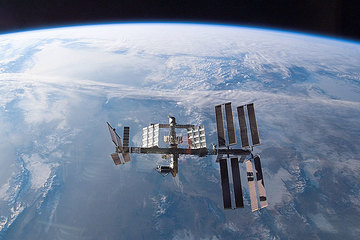 Space Center Houston
Space Center Houston
|
Next Challenge: How can we improve the DIY lawn care experience? |

High concentrations of carbon dioxide can lead to a variety of problems in long duration spaceflight. These problems range from headaches and dizziness to more severe conditions such as impaired cognition and performance, and possibly contribute to the visual acuity problems reported by some astronauts, as well as, in high concentrations, death. This presents a difficult issue for spaceflight as the station or vehicles are a relatively closed system, relying on filters, or scrubbers to remove carbon dioxide (CO2). Indeed, the buildup of CO2 in the Lunar Module was a critical problem to be quickly resolved for the safe return of the Apollo 13 astronauts.
Currently the maximum allowable CO2 concentration for long duration spaceflight is set at 0.7% (CO2 concentration on Earth is 0.04%), which is a level lower than that set by the US Navy for submarines. The gas is currently being filtered or scrubbed through removal of moisture in a desiccant bed of silica and then removal of CO2 in a zeolite bed. The ambient concentration is monitored via wall sensors, however it is believed that these readings may not fully represent the levels in close proximity to the astronauts, as pockets or bubbles of CO2 may be present. Therefore, to fully monitor the CO2 levels and health implications for the crew, a device or mechanism for the monitoring of personal CO2 levels is desired.
Show us your design for a personal CO2 monitor for use in long-duration spaceflight. Specifically:
- Submit a visual of your design. High-resolution designs using rendering software are preferred, but well-made sketches in other forms will be accepted.
- Explain how your device does the following:
- Monitors CO2 levels in the immediate vicinity of the crew member, preferable near the mouth and nose.
- Is unobtrusive so as to minimize crewmember discomfort and distraction.
- Is operable in a weightlessness environment.
- Stores or transfers accumulated data.
- Allows sensitivity to ambient CO2 levels.
AVOID: NASA has developed a prototype of a personal CO2 monitor and has tested it onboard the ISS. Results are pending.
-
Submissions will be graded on the following criteria:
- Meets Deliverables
- Creativity
- Clarity
will receive $800
will receive $200 each
| $800.00 |

|
Matthew Gaiser Queen's University | |
| $200.00 |

|
osasumwen obasogie landmark university | |
| $200.00 |

|
Dat Tran The Catholic University of America | |
| $200.00 |

|
Komal Prasad Institute of Chemical Technology | |
| $200.00 |

|
K R Georgia Institute of Technology |